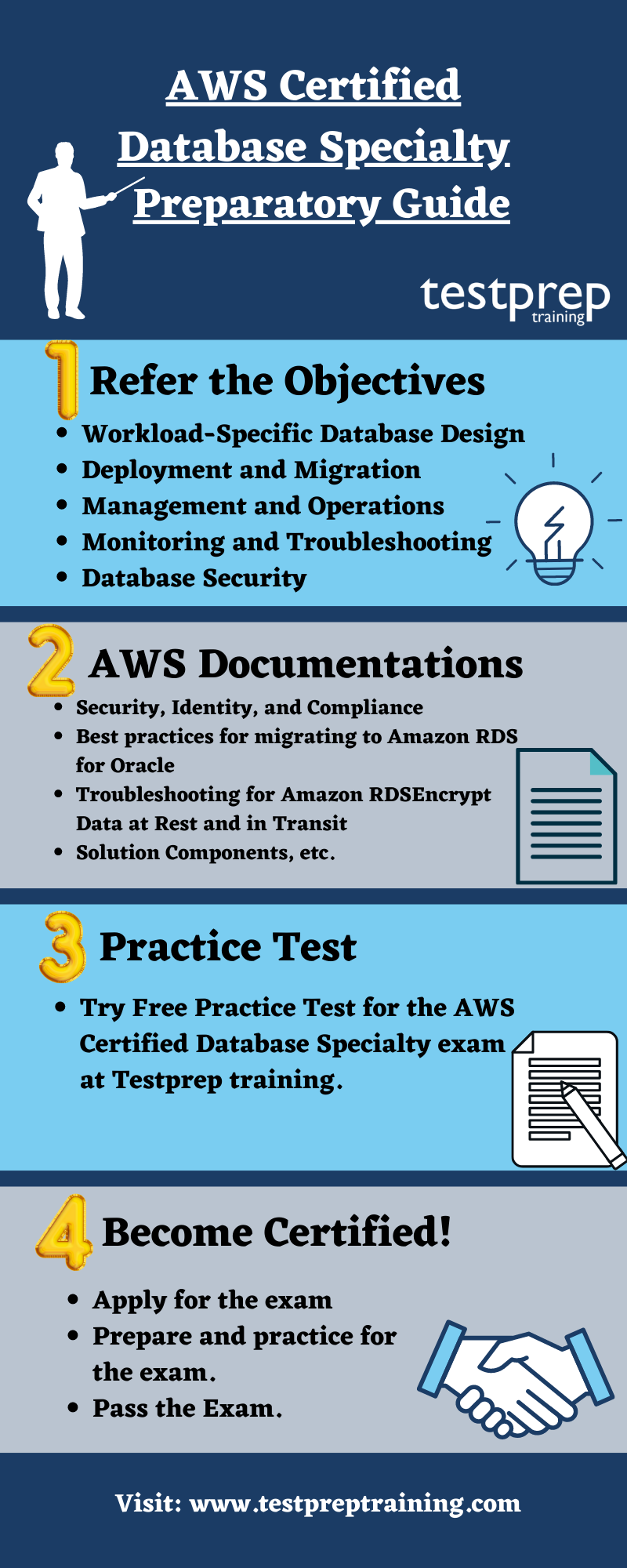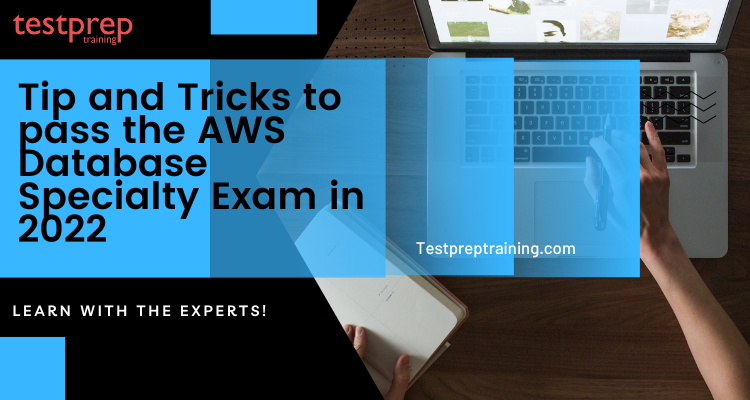The AWS Database Specialty Exam is a certification exam offered by Amazon Web Services (AWS) for database professionals who want to demonstrate their expertise in designing, deploying, and managing AWS database solutions. The exam is designed to test the candidate’s knowledge and skills in various areas, including AWS database services, database migration, database performance, database security, and data modeling.
Passing the AWS Database Specialty Exam is essential for career growth, especially for professionals working with AWS databases or aspiring to work with AWS databases. The certification provides validation of your skills and expertise in AWS database services, which can improve your job prospects, increase your earning potential, and enhance your credibility as a database professional.
To pass the AWS Database Specialty Exam, you need to have a solid understanding of the exam blueprint and format, as well as a thorough knowledge of the AWS database services and related concepts. In this blog post, we will provide tips and tricks to help you prepare for and pass the AWS Database Specialty Exam.
Let us dive deeper into the exam details to get a clear idea about the exam.
Exam Format
The AWS Certified Database Specialty exam has 65 questions to answer in 180 minutes. You must plan your time wisely. Furthermore, because there are 65 questions in total, you should spend no more than 1 minute 30 seconds on each question. If you finish your exam in 150 minutes, you will have 30 minutes to go over your answers and revise them.
In addition, the exam includes a variety of question types such as case studies, short answers, multiple-choice, and mark review. Because there are various types of questions, you should begin with the case study questions. As a result, they take the most time. Following that, you have the option of answering short answers or multiple-choice questions. Keep in mind that passing the exam requires a score of 750 or higher. Furthermore, the exam will cost you $300 USD. Finally, the exam is available in English, Japanese, Korean, and Simplified Chinese.
Let us now move to the main topic of discussion –
AWS Database Specialty Exam: Focus Skills and Strategies to Pass the Exam
These are some of the strategies that you can follow will help you get through the exam –
Develop skills to identify workloads best suited to each of AWS’s purpose-built database services
When incorporating a new database solution into architecture, it is critical to consider the data’s nature, such as storage, usage, volume, and velocity. AWS database services can vary greatly in terms of performance, scalability, and availability. Understanding the strengths of each service and matching workload characteristics to the various services is a critical skill that is heavily tested on the exam. Workload-specific database design now covers almost 26% of the exam content.
Refer –
- AWS Public Sector Summit presentation: Building with Purpose-Built Databases: Match Your Workload to the Right Database
- Blog post: Build a Modern Application with Purpose-Built AWS Databases
Ability to understand disaster recovery and high availability strategies
It is critical to understand how to configure database architectures to achieve recovery-point and recovery-time objectives when deploying databases on AWS. This exam topic covers high-availability and disaster-recovery configurations for a variety of database services. This topic is closely related to the AWS Well-Architected Framework’s Reliability Pillar.
Refer –
- Webpage: Amazon Relational Database Service (Amazon RDS) high-availability architecture concepts
- Blog post: Cross-Region disaster recovery of Amazon RDS for SQL Server
- Documentation: Disaster-recovery strategies for Amazon Aurora databases
Ability to automate database solution deployments
Using a configuration system that treats your infrastructure as code is a best practice for deploying AWS resources. AWS CloudFormation is one method for accomplishing this on AWS. Infrastructure as code is an important enabler of DevOps practices, bringing together developers and operations to collaborate on automating application delivery at scale. Because databases are typically stateful components of your architecture, understanding how to use CloudFormation to provision new resources and manage them throughout their lifecycle is critical.
Refer –
- Blog post: Using CloudFormation to configure auto scaling for Amazon DynamoDB
- Documentation: CloudFormation User Guide
Develop skills to plan out data preparation and migration strategies
The exam assesses your understanding of data migration methods both into and out of AWS. You must first understand capabilities such as snapshots, database restores, and data-replication options to answer these questions. To maximize efficiency, ensure you understand which tools and services are most appropriate. Know how to prepare your data sources and targets, as well as how to select schema-conversion methods using tools like the AWS Schema Conversion Tool.
Refer –
Blog post: Migrating a commercial database to open source with AWS SCT and AWS DMS
Develop skills to plan backup and restore strategies
Determine appropriate backup and restoration strategies to ensure business data security. Backup and recovery strategies will differ depending on the AWS database services used. Data-protection strategies may include the ability to take manual snapshots while also utilizing automated backups or continuous backups. The resource impact of backup and restoration activities can also vary. Backup solutions for AWS database services like Aurora and DynamoDB are designed to have little to no impact on performance and cause no interruptions. In other cases, such as Amazon ElastiCache, potential consequences are determined by engine version, activity level, or configurations such as reserved memory. Consider the effects on performance and availability, as well as mitigation strategies.
Ability to manage a database solution’s operational environment.
A number of AWS database services are available as fully managed database services, which means that AWS handles many aspects of database management on your behalf. This could include, for example, applying patches to the database engine or its underlying operating system. Because there are some differences between database services, make sure you understand how they handle updates and configuration changes.
Develop skills to plan your monitoring and alerting strategies
You’ll also need to be familiar with AWS database monitoring capabilities and how they interact with other AWS monitoring and alerting tools, such as Amazon CloudWatch, AWS CloudTrail, and the collection of custom metrics.
Refer –
Documentation: Performance Insights dashboard documentation
Develop skills to improve database performance
For the exam, you’ll need to troubleshoot database performance issues, fine-tune database design and performance, and identify AWS tools and services that are most helpful and cost-effective for database scenarios. The method for optimizing performance and costs differ between AWS database services. In DynamoDB, for example, design your application to ensure consistent activity across all logical partition keys in the table and its secondary indexes.
Refer –
- Blog post: Sharding with Amazon Relational Database Service
- Webpage: Amazon RDS Read Replicas
Focus on developing skills to encrypt data while it is at rest and in transit.
Encrypting data at rest is a critical component of AWS data protection. AWS database services are distinct and frequently implement data protection in novel ways. Understanding how to use AWS Key Management Service (AWS KMS) for encryption key management to create encryption keys and define the policies that govern their use is likely to come up in the exam. Spend some time reviewing the options for the various database engines that support data encryption in transit.
Refer –
Blog post: Select the right encryption options for Amazon RDS and Amazon Aurora database engines
Ability to identify the mechanisms for access control and authentication.
Authentication options differ depending on the database service. Learn about the database services that support authentication through AWS Identity and Access Management (IAM). Know how to handle database credential management in configurations that rely on native-database authentication schemes by using AWS Secrets Manager, which allows you to create secrets and use them in place of hard-coded credentials in your applications or infrastructure as code.
AWS Database Specialty Exam Preparation Guide

AWS Training Programs
The candidate may choose to participate in AWS training programs. For each exam, AWS offers training programs. All exam information, such as the description, intended audience, delivery method, duration, and so on, are included in the training programs for a specific exam. The candidate should enrol in a training program to gain knowledge and skills for AWS Certified Database Specialty.
Get familiar with the basic exam terms
Here are some key terms related to the AWS Database Specialty Exam:
- Relational Database: A type of database that stores and organizes data into tables with predefined relationships between them.
- NoSQL Database: A type of database that stores and retrieves data without using the traditional SQL query language. NoSQL databases are often used for big data and real-time web applications.
- Data Warehousing: A technique for collecting and managing large amounts of data from different sources to support business intelligence and decision-making.
- OLAP: Online Analytical Processing, a technology used in data warehousing that allows users to analyze and interact with data in a multidimensional way.
- OLTP: Online Transaction Processing, a technology used in traditional relational databases for processing real-time business transactions.
- Data Migration: The process of moving data from one database or data storage system to another.
- Data Replication: The process of copying data from one database or data storage system to another in real-time.
- High Availability: A measure of system uptime and availability, typically expressed as a percentage. High availability systems are designed to minimize downtime and ensure that services remain available to users.
- Disaster Recovery: A set of policies, procedures, and tools used to recover from a system failure or other catastrophic event.
- Multi-AZ: A feature of AWS database services that replicates data across multiple availability zones to ensure high availability and data durability.
Review AWS documentation and whitepapers
AWS provides a wealth of documentation and whitepapers on their website that cover various database-related topics. Reviewing these resources can help you gain a better understanding of the exam content and prepare you for the exam.
Online Tutorials
Online tutorials supplement your knowledge and help you understand exam concepts thoroughly. They also discuss exam details and policies. Nonetheless, these online tutorials provide comprehensive exam information. You will be better prepared for the exam as a result. As a result, learning with Online Tutorials will assist you in better preparing.
Practice Exams
Practice exams and test series are critical steps in preparing for the AWS Database Specialty exam. The practice papers help in identifying weak areas in your preparation. They make you feel more confident and less strange when you actually take the exam. You should take test series on a regular basis so that you can work on and improve your weak points.
Gain hands-on experience with AWS database services
Hands-on experience with AWS database services can be invaluable when preparing for the exam. Try to create and manage databases on AWS, and practice using AWS database migration and replication tools.
Join AWS online communities and attend events
Joining online communities and attending events related to AWS database services can help you stay up-to-date with the latest industry trends and best practices. It can also provide you with an opportunity to connect with other professionals in the field and learn from their experiences.
Amazon Blogs
Also, You can prepare for the AWS Database Specialty exam by reading blogs provided by Amazon. You can also freely ask your questions in the cloud communities. Cloud communities are made up of people who have passed a similar exam. You can even form groups with people who share your interest and want to pass the AWS Database Specialty exam in order to pool resources and other benefits.
Review your exam content and take notes
Finally, as you prepare for the exam, review the content regularly and take notes. Writing down key concepts and ideas can help you retain the information better and make it easier to recall during the exam.


